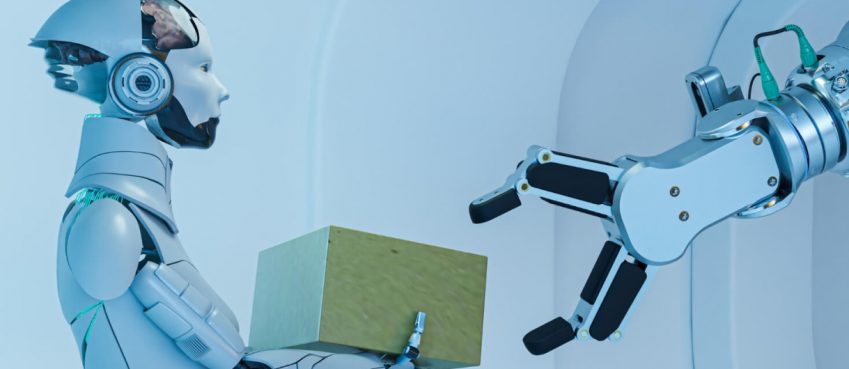
Artificial Intelligence (AI), one of today’s most ubiquitous technologies, is one. Conversational AI (CAI), which is based on the human language, is quickly becoming the most popular frontier in this technology. Many businesses are enlisting the help of this technology to stay competitive.
According to Markets and Markets, the expected global Conversational AI market size is set to grow from USD 4.8 billion in 2020 to USD 13.9 billion by 2025, at a Compound Annual Growth Rate (CAGR) of 21.9%.
Companies, leaders in the industry, and employees must understand exactly what Conversational AI is and why it’s so important.
What is Conversational AI?
Conversational AI, a subset of AI, aims to imitate human conversations and deliver a human-like experience. These types of AI aim to imitate the human experience as closely as possible. Machine Learning technologies such as Natural Language Processing (NLP), and Natural Language Understanding(NLU) — Conversational AI seeks to understand and process language data (what people say) and interpret it (what they mean).
Conversational AI can also use other technologies such as speech recognition, sentiment analysis, and dialogue management to help them respond appropriately. Conversational AI requires input data from humans to be able to understand and communicate with one another.
Conversational AI can be seen as an evolution of chatbots, which were one of the first applications of AI. Conversational AI allows for more contextualized conversations, unlike chatbots that follow a strict script. Conversational AI can be more complex and nuanced than chatbots because it can understand language at a deeper level.
Why is Conversational AI important?
It’s not a question of whether, but when.
It’s easy to see why Chatbots are so popular. ACCORDING TO JUNIPER RESEARCH, Conversational AI solutions can scale, provide 24/7 service and asynchronous conversations, and are forecasted to have operational cost savings in industries like banking of $7.3 billion globally by 2023.
It is not enough to have chatbots on your website by 2021. Businesses need to have intelligent chatbots with natural language processing and understanding for the best customer support experience.
Chatbots are expected to be more understanding and helpful than what they can find in FAQs. When done right, Conversational AI can provide a customer experience that is equal to or better than live chat.
A handshake between a bot, website, and bot is also important. A bot can’t replace or compete against a website. The best chatbot designs involve the bot and site working together. Conversational AI bots are not only a way to reduce call center costs, but also provide better customer service and engagements.
Armed with the machine learning technologies, it is not surprising that Conversational AI applications are behind many chatbots and devices that exist in the market today, proving to be a core component to social success.
5 Best Industry Use Cases for Conversational AI
As Conversational AI becomes more useful for more uses, the industry of Conversational AI is experiencing explosive growth. These are the top five industries and their CAI use cases. They all aim to improve customer service and interaction and enhance user experience.
1. Healthcare usage cases for Conversational AI
As it becomes more apparent that Conversational Artificial Intelligence can reduce costs and improve patient experiences, the healthcare industry is experiencing a paradigm shift. This new technology is not only changing patient care, but it has also impacted the way we do business.
Chatbots ai solutions are now helping to cut down on the time spent by human medical assistants and to help patients understand their treatment plans using natural dialogue.
Use cases for Conversational AI for the healthcare:
Diagnosis: Conversational Ai can diagnose conditions online by asking patients a series of questions and then learning from their answers to gain insight into potential health issues.
Medical scheduling: A conversational AI system can help patients schedule their appointments by giving them general information about their next visit before they arrive at the hospital. It can help patients schedule appointments and manage their paperwork.
CBT: Cognitive Behavioral Therapy is a powerful way to manage anxiety and other mental health issues. Conversational AI with NLP or NLU can create a fully immersive CBT experience.
Therapy: The use of conversational AI in therapy can fill the gaps between human clinicians and mental patients. Conversational AI can provide 24-hour service. This means that it can be used for as long as needed without the need for breaks or days off. Bots are also unbiased and don’t judge patients. This is a significant benefit for mental health.
Mental Health: Replika bots are chat-bots that can assist with emotional counseling. They provide a private and safe space for people to express their emotions. Conversational AI can also be used to assist therapists by taking notes and summarizing sessions.
Virtual assistant for patients and carers: A conversational AI assistant can help them understand medical topics. This can help reduce stress in healthcare by freeing up medical assistants to do more important work.
Data collection: Pharmaceutical companies are also using Conversational AI to gather user feedback via focus groups or surveys. This is done without the need for an interviewer. This allows for both savings on time and money in hiring data collectors. However, it still collects valuable information from customers that can be used to analyze Conversational AI’s Natural Language Processing capabilities.
2. Internet of things (IoT) devices
Conversational AI-enabled devices, which use speech recognition to interact with users, are perhaps becoming a more valuable helper in the home. These devices include voice assistants like Amazon Echo and Google Home, as well as a mobile, smartwatch, and desktop assistants like Apple Siri or Cortana.
Conversational AI bridges the gap between humans, non-human interfaces and can understand natural speech patterns and allow context to be provided without having to follow a set conversation structure.
Unsupervised machine learning is used in many of these devices. Conversational AI’s capabilities are learned through trial and error, as well as user input.
Some of the use cases for this industry include:
- It can control your home appliances via google or Amazon Alexa.
- Any device that can “dial” phone numbers or sends messages to the user is being monitored.
- Conversational AI-enabled apps and devices like Amazon Alexa allow you to order food or groceries, while simultaneously learning about your preferences so that you can suggest products that may interest you.
- Remotely, it can perform tasks like turning on the lights and air conditioner.
3. Retail use cases for Conversational AI
Conversational AI is a rising trend in retail: lead generation, lead qualification, and lead nurturing to 24/7 concierge service, faster order fulfillment, and amplifying marketing messages.
Through smarts like API integrations, other use cases for retailers with conversationally enabled applications include:
Product Recommendations: Retailers use Conversational AI to make product recommendations based upon user interactions.
Customer Data Insight: Conversations with customers can be recorded digitally. This eliminates the need to record every word said during a conversation or call center conversation. Businesses can gain additional insight into their products and services by simply analyzing the search queries they are being asked.
Multi-Channel Integrations and Scalability: Conversational AI can scale conversations across multiple channels simultaneously (email to web assistance to Facebook), without the need for human intervention. This increases conversions and sales while reducing the costs associated with traditional communication methods that require human intervention such as phone calls.
Improved User Experience and Engagement: Conversational Artificial Intelligence can be used in retail settings as ongoing conversations as well as for one-off conversations. Better customer experience, engagement, and conversion rates will be achieved by keeping track of context and holding on to data from previous conversations.
Inventory tracking: Conversational Artificial Intelligence allows you to track inventory and provide availability to customers.
Conversational AI can help businesses provide the best online shopping experience in 2021 by offering the right information to customers 24/7.
Also read: Top 10 Business Intelligence Tools of 2021
4. Human Resources
Conversational AI is also being used by companies for HR purposes, from recruitment to document directory. Companies will find their resources are more efficient, which can increase productivity, maintain staff satisfaction, and save time and money.
The most common use cases for an HR bot are:
Recruitment: Conversational AI can be utilized to filter through CVs and employment forms, killing a requirement for HR staff to go through each application physically.
The capacity to investigate information, for example, catchphrases found on the CV contrasted with other candidates’ hunt terms implies that these AI can furnish organizations with a more exact rundown of potential competitors than any HR could.
Onboarding: Conversational AI can be utilized to robotize onboarding and direction measures, incorporating prompting new representatives with any fundamental data they need about their work before they start work, for example, where washrooms are found.
Simulated intelligence chatbots additionally have a UI that is more natural than any HR staff part will at any point have and can recollect each discussion with a representative.
Documentation: AI can computerize documentation measures, which implies that HR staff won’t continually refresh their records. Conversational AI’s memory work additionally guarantees every one of representatives’ archives is modern continuously.
General staff warning: Acting as an attendant service or an assistance work area, the utilization of Conversational AI stretches out to respond to any inquiries, rounding out leave applications for representatives, and mechanized shift date and updates.
5. Finance and Banking
According to a recent study by Juniper Research, the success rate of bot interactions in the banking sector will reach 90% in 2022. Digitalized customer experience strategies like Conversational AI are the best way for financial institutions to stay competitive.
Conversational AI is currently making waves in the world of finance and banking, with use cases including:
- Banking virtual assistant bots can check user balances and process transactions across all bank accounts.
- It detects any phrases or keywords that may indicate fraudulent activity and prevents fraud using automatic speech recognition. Conversational AI can also detect anomalies in normal behavior that could indicate fraud.
- Finance bots can process all transactions and provide you with a complete picture of your finances. Conversational AI can access and analyze data such as spending patterns or bank accounts to help you decide how to spend your money.
The Bottom Line
In 2021, conversational AI promises great potential. Many industries have excellent AI. Conversational AI: Use cases Healthcare, Finance, IoT devices, and Retail, as well as Public Sector, Health, Human Resources, IoT, IoT, Banking and Financial. Each one promises to revolutionize the way that industry works.
Chatbots are a conversationally enabled application that can transform customer service from average to outstanding — they can help companies in Customers can save up to 30% on customer support and get answers to up to 80% of their routine questions.
Let’s get back to the point. It may seem like Conversational AI is simple to implement, an all-encompassing force to reckon with. However, it is important to remember that a chatbot can only be as good as the solution it provides and the conversation design and platform that supports it.
Because humans are better at communicating with each other, conversational AI chatbots must be human-curated. Although Conversational AI cannot replace human-to-human interactions and conversations, it is certainly improving.
Top 10 News
-
01
10 Exciting iPhone 16 Features You Can Try Right Now
Tuesday November 19, 2024
-
02
10 Best Anatomy Apps For Physiologist Beginners
Tuesday November 12, 2024
-
03
Top 10 Websites And Apps Like Thumbtack
Tuesday November 5, 2024
-
04
Top 10 Sites Like Omegle That Offer Random Video Chat
Monday October 21, 2024
-
05
Entrepreneurial Ideas To Make 5K In A Month (10 Realistic Wa...
Monday October 7, 2024
-
06
[10 Best] Cash Advance Apps Like Moneylion And Dave (No Cred...
Friday September 20, 2024
-
07
Top 10 Richest Person In The World
Tuesday August 27, 2024
-
08
Top 10 Unicorn Startups In The World (2024-25)
Monday August 26, 2024
-
09
Top 10 IT Companies In The World By Market Cap
Thursday August 22, 2024
-
10
[10 New] Best OnionPlay Alternatives To Stream TV Shows And ...
Tuesday June 11, 2024







